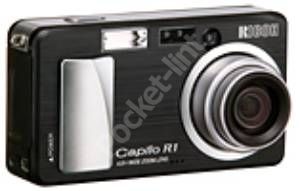If you think you've seen this camera somewhere before, it’s because the spec is virtually identical to Ricoh's Caplio RZ1. This model features a 4.8x, 28-135mm (35mm film camera equivalent) wide-zoom lens. Its brother, the Caplio RZ1, features a slightly slimmed down specification and a more ‘traditional’ 35-105mm 3x optical zoom lens. Apart from the lens focal ranges involved, the cameras are very similar, featuring 4MP effective resolution that is ample for prints all the way up to A3.
Our quick take
The R1 is versatile indeed; it is sturdily built, attractive and offers great wide-angle snapping options all at an attractive price. Niggles I had with the lens cover meant it was not totally magic. That aside, the R1 takes superb pictures let down at the last by the softness at the edges (see sample images).

Ricoh Caplio R1 - 3.5 / 5
| FOR | AGAINST |
|---|---|
|
|
Styling is much improved over older Ricoh incarnations, the R1 being only 25mm ‘thin’ and is of the brushed, all-metal, very shiny type of digicam. Its neat slimline design hides its lens behind an automatic (body integral) flip round metal lens cover and a large sliding ingot-like on/off switch on the front.
The lens cover looks funky as it zips Paul Daniels-like in and out of view, but like Paul Daniels, it was also the source of some frustration. It does not always move away far enough to allow the lens out of its port when you turn the camera on. And occasionally, it did not fully close properly either, even if the lens retracted home fully.
A slight tap on the camera encouraged the lens cover to either get out of the way or vice versa at shut down. But whichever way it went (or rather didn’t) it was just like Paul Daniels - not as magic as it should have been.
On a more positive note, some of the camera’s better features include a superb 1cm macro mode, which enables some amazing close up shooting options. Metering is extremely good and highlight and shadow capture mark the camera’s image processing out as extremely good, particularly capturing fine cloud detail in some of my shots.
The camera’s wide-angle zoom lens is extremely versatile, allowing you to cram in plenty of the scene you wish to shoot. On close inspection though, particularly of wider images, the periphery of the lens is not sharp, loosing critical bite at the edges. The lens also exhibits alarming barrel distortion, although to be fair, most wide lenses exhibit this problem to some degree.
The AF set up is good and the camera’s ISO equivalence (its sensitivity to light setting) offers an above average range for a camera of this type, from ISO 64 to ISO 800, including the ubiquitous Auto option. Colour capture is superb and control of image noise in low light is commendable up to around ISO 400. Beyond ISO 400 things start to get a patchy, but for a digicam at this level it’s still very good.
While you don’t get Debbie McGee to help you control the camera, it is neat and simple to use in both terms of handling and within menu options thanks to very clear menus when setting in depth options such as metering or adjusting the date and time. Furthermore, the simple control layout provides intuitive controls placed alongside the camera’s 1.8-inch colour screen.
A good example is the single-sliding shooting mode switch adjacent to the optical viewfinder. It flips from sound memo recording mode, through to still capture to the 320x240-pixel movie-recording mode (up to the limit of the SD/MMC storage or the limit of the built-in, 12MB internal memory) and all with sound. A playback button is placed centrally within the switch, it is pressed to review images or video and must be pressed again to return to the capture mode.
USB connectivity, flash modes that include redeye reduction, slow synch and forced flash join with exposure compensation to +/-2EV for fine tuning exposures in brighter or darker lighting conditions and compete this cameras key features.
To recap
The Caplio R1 offers a compact, all-metal, stylish design that houses a true, 28mm wide-end to its zoom lens and resolution enough for prints up to A3.
